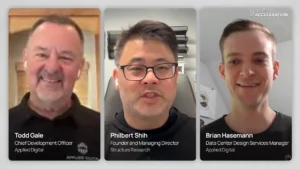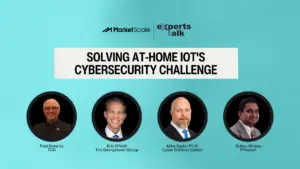As Congress Seeks Feedback on IoT Adoption, IoT Experts Should Seek Opportunities for Cross-Discipline Collaboration
In August 2023, the National Institute of Standards of Technology (NIST) put out a request for comments on the Preliminary Update from the Internet of Things Federal Working Group (IoTFWG), which aims to provide the nation direction on how to improve IoT adoption and expand its use cases for the future of industrial, corporate, and residential productivity. The working group’s objectives encompass exploring how Federal agencies can benefit from IoT, strategies for increasing IoT adoption in key sectors, ensuring the secure use of IoT, especially for critical infrastructure, and enhancing the resilience of Federal systems against IoT-related cyber threats.
In its most recent update, the Working Group landed on a few key strategies, mostly involving public-private coordination, for speeding up and increasing the reach of IoT adoption. These methods include:
- Government-based cooperative research and development
- Federal technology’s transferability
- Government-based outreach and engagement
- Grants
- Federal coordination with nongovernment entities
While the comments they are requesting are broad, it’ll be interesting to see if the general public and IoT industry experts agree with these strategic pillars for IoT adoption, and the industries the Working Group says are most likely to encourage this adoption, like healthcare, energy and the supply chain. IoT’s adoption in the U.S. has lagged behind other countries, specifically the UK which has committed to utilizing IoT methodologies to reach net zero carbon emissions by 2050. So what is left to be done to close the gap between the U.S. and their counterparts?
Dr. Aryan Kaushik, Assistant Professor at the University of Sussex, believes that there are actionable steps the U.S. can take to reach its goals. These steps rely heavily on proper coordination of grants, engagement with all stakeholders, and tapping into existing frameworks.
Dr. Aryan Kaushik’s Thoughts
“Yes, this report is presented by the IoT Federal Working Group, signed by NIST, right, so it has presented quite well-aligned sort of goals and objectives to implement IoT for various applications. So basically some of the things that really kind of attracted me were IoT public safety, let’s say, so they had mentioned public safety sort of applications using IoT, right, then they had mentioned sustainability and resilience of the network and basically reliability of the network as well. So from a technical standpoint of view, it looks really well aligned with what is happening currently in the market, in technical markets, and in terms of the, you know, improvements in technology as well.”
IoT and the UK’s Environmental Strategy
“So if you talk about the UK, our main goal has actually been to provide net zero, right, so decarbonizing the emissions that we have. So we have a goal by 2050 to achieve the UK’s net zero target, right? So if you look at the report, the initial sort of prediction of IoT technology in the US, so it does cover some points about cost efficiency, it does cover some points about reliability and sustainability of the network, which again, you know, aligns very well with UK’s strategy as well. Then we also have one broadband rollout very recently, which is the government’s target to provide about 85% of the UK, maybe by 2025, to provide 85% of gigabit speeds, right? So if you talk about IoT sort of applications, that can also come to that, right.”
6G Framework and its Relation to IoT
“And then one more interesting thing was that this adoption of IoT approaches aligns very well with ITR approved 6G framework that we have. If you talk with telecommunication and industrial telecommunication personnel, this seems to be aligning quite well with what is happening at the moment, what we can actually implement, and what kind of applications we can have using IoT sort of technologies. So that would be my initial comment.”
Broad Scope and Maturity of IoT
“So again, the technology is not super mature yet. I think IoT is a very wide term, right? So if you have different networks, let’s say, if you include different non-Christian networks, that becomes your internet of, let’s say, airborne networks or internet of space things, right? So it’s a very wide term. It includes a lot of terms. It can provide us with an umbrella for a lot of terms. But I think it’s not really mature enough at the moment, but I think this is the direction. And then it looks like that the draft or the preliminary report looks quite right in the direction of the technical advancements.”
Challenges in Implementing IoT
“Yes, I think to implement all these technologies, as I just mentioned, they need a lot of coordination between different entities, right? So government needs to coordinate through grants with academics in the US, with collaborators, and with sort of industry stakeholders as well. So they need to coordinate quite well with the people around them. And one thing is also the regulators, for example, as we know that spectrum is a bit of a congested issue, right? We have the spectrum that we allocate for different IoT applications is congested at the moment, which is, you know, the microwave spectrum that we talk about. So kind of reuse of the spectrum and kind of going through high-frequency sort of ranges or, you know, I’m just giving an example. So let’s say you want to jump to millimeter wave sub-terahertz or terahertz sort of frequencies. So spectrum allocation will be decided by government bodies, right?
But then if you kind of have coordination with industry stakeholders about the spectrum reuse, about the spectrum sharing for different applications, because at the end of the day, they are the ones providing the technology, right, the IoT technology. So this coordination is of paramount importance between the government, the government entities, and the industry stakeholders. And again, you have to involve academics as well, because they are the ones coming up with these dreamy ideas, right, where they’re presenting a dream sort of thing. And, you know, I mean, with some assumptions and stuff. But at the end of the day, industry stakeholders are implementing them and making them into reality. Right.”
Future of IoT and Challenges
“So really, it requires a coordination between all these bodies and also through grants, as you mentioned as well, is a good step ahead to kind of have more grants given to the academic personals for, you know, kind of advancing the IoT technology. So these, I think from the draft, look really like the strong pillars. And they, again, look in the right direction from what I have read. So I think we have pretty much covered everything. But again, I would like to summarize what we have just mentioned. So, I mean, it looks great on paper. But I think there are many challenges and many less, a lot of limitations, hardware limitations to implement all these nice approaches that we see from our academic friends. So we really need to be concerned about the efficiency of these IoT solutions. So how cost-efficient they are.
Are they aligning very well with the net zero strategy of, let’s say, many Western, you know, kind of developed countries that we have? Are they aligning very well with gigabit sort of speeds? Right. So when you are talking about connectivity, it has to be fast connectivity as well. Are they taking into account a lot of technical advancements? Right. As you’re taking into account less and don’t trust the networks or integrated AI and communications, integrated sensing and communications, and so on. So are you really taking into account the new technologies to implement IoT solutions? And also, do we have coordination between different state regulators and the academia and industry sort of stakeholders? Do we have the coordination to actually make these techniques feasible? So these are some of the key points that I would like to summarize out of a discussion that is very important when we talk about IoT technology being implemented at a large scale.”
Article written by Shanice Bennerson.








